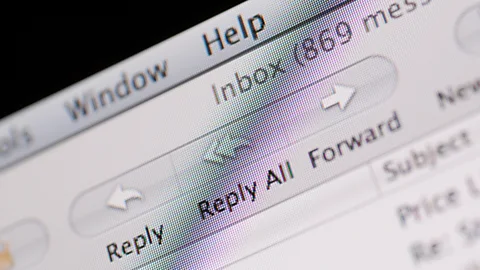The surprising benefits of a reply-all email storm
 Getty Images
Getty ImagesIn early November, 840,000 employees at NHS England received the same email telling them that they’d been added to an email distribution list. Sent in error by an employee, that email set off a wave of replies. Thousands of recipients responded with “please unsubscribe me” and other complaints about their colleagues’ responses to the original note. It’s estimated that 186 million messages were sent in response to the email.
While this is an extreme case of a “reply-all” incident, most of us have probably experienced something similarly annoying at least once. Employees at Thomson Reuters will likely remember the message sent to 33,000 staff, which resulted in an all-day inbox-clogging catastrophe. And in October, an editor at Barron’s accidently emailed the entire company about yet-to-be-announced layoffs. While no one responded in that case, the content of the email still left a lot of people stunned at the news.
Generally, “reply-all” email chains are the most irritating kind of emails we can get. They can overload emails systems, creating massive slowdowns, and can cause grave embarrassment to the sender if things go awry. Usually, nothing of value comes out of the myriad messages that are sent. But every now and then, something positive does arise from these frustrating back-and-forth exchanges — some companies even encourage the workers to use the “reply-all” email feature and think it can be used for good.
For example, when two staffers at Scorely, a credit-monitoring company for small businesses, got into a tiff over email a couple of months ago, where one challenged a design change, a heated dialogue between the two ensued with the rest of the company’s nine-person staff copied in via CC.
 Alamy
Alamy“I was in back-to-back meetings while this was going on, but every time I glanced at my phone I could see the same subject line,” says Shawn Porat, Scorley’s co-CEO. “I knew something was going on.”
At some point another employee chimed in, suggesting in a message that they should test their ideas instead of talking about them over email. Porat, then sensing that he needed to defuse the situation, sent another reply to the team saying he appreciated everyone’s passion and he’d like to take everyone out for dinner to go over what was being discussed.
Later that evening, the entire staff went out, and while they chatted about the design issue, they also talked about other company business and just had a good time. That sparked a bi-weekly team-building dinner.
“Something 100% positive came out of that email chain,” says Porat. “If it didn’t happen we wouldn’t have had that dinner and we wouldn’t have added this team-building exercise piece to the business.”
 Alamy
AlamyA team-building boost
Mary Waller, professor of organisational studies at Toronto’s Schulich School of Business, also thinks that reply-all chains can be used for good. Depending on how people react, they can bring a team closer together. If the email gets people sending funny messages to each other, and if the original sender is in on the joke, then it can inadvertently turn into a fun team-building activity.
Several studies show that when colleagues joke around it can increase creativity, reduce stress and improve the cohesiveness of a team, Waller says. While the research doesn’t focus on email specifically, she thinks the same findings would apply to a humorous reply-all apocalypse.
“If the sender can laugh off the mistake in the first place, then it can become funny,” she says. “It can become a competition where people try and one up each other with a more humorous retort.”
The reply-all back and forth can also be useful when teams in pressure situations need to communicate with each other quickly. A medical emergency team might send a message about a patient in critical condition or a nuclear-power-plant crew might use the reply-all function to communicate in a crisis.
 Getty Images
Getty Images“It builds a shared mental model where people can get an understanding of a situation,” says Waller. “It can then turn into a conversation where people can say ‘I didn’t know that, and did you know this,’ and it turns into a good process for sharing information.”
Know thy neighbour
The message mayhem can also give us insight into the people sitting around us, says April Masini, a relationship and etiquette expert who runs an “Ask April” advice column on her website. If our colleague sends a nasty message back, or hits send on a funny message, then that may tell us something about them.
“You can see people’s true colours, for better and for worse, in a reply-all fiasco,” she says. “And while you may be disappointed in what you learn, it’s always good to have clarity.”
Certainly, many people were disappointed, if not downright upset, when Barron’s president Ed Finn sent an email about layoffs to the entire Wall Street Journal company. He had received a note from the Journal’s editor-in-chief announcing voluntary buyouts and responded by asking how those buyouts would impact layoffs. The firings weren’t yet revealed to the company’s staff.
There’s no question that this was incredibly embarrassing for Finn. Not only did several media outlets write about it, but he also had to email some of those outlets saying that he had made a mistake.
Fortunately, in most cases the only consequence of sending an email to everyone is embarrassment, says Waller. However, depending on how bad it is, that mistake may impact the sender’s career progression. “Especially if the incident becomes woven into the organisation’s culture as folklore,” she says. “Remember the time that so-and-so hit reply all?”
The upside of cc: all
At Michaela Kron’s workplace, reply-all messages are always used for good, she says. When someone starts at Duolingo, an online-language-learning-platform business, the CEO sends out a message welcoming the new employee to the company. Throughout the day, the rest of the staff congratulates that person with a message of their own and those notes are typically sent to the entire 75-person operation.
 Alamy
AlamyOn Kron’s first day, she received 40 messages and nearly all went company wide. The same thing happens on birthdays. While it was strange to get a flood of positive messages, this company tradition helps reinforce its culture.
“We’re very much a family culture here and we’re supportive,” she says. “That comes through in in these reply-all email threads and when they’re done in a positive manner.”
So, the next time you get caught in a company-wide email blast, consider using your reply-all powers for good. Send a positive note, a funny message, an invite for dinner or, perhaps, don’t reply at all. The trick is to keep in mind how others might react to your response.
“The dos and don’ts of email communication are unique for every organisation,” says Waller. “Get a feel for how they treat the reply-all before you send your response.”
